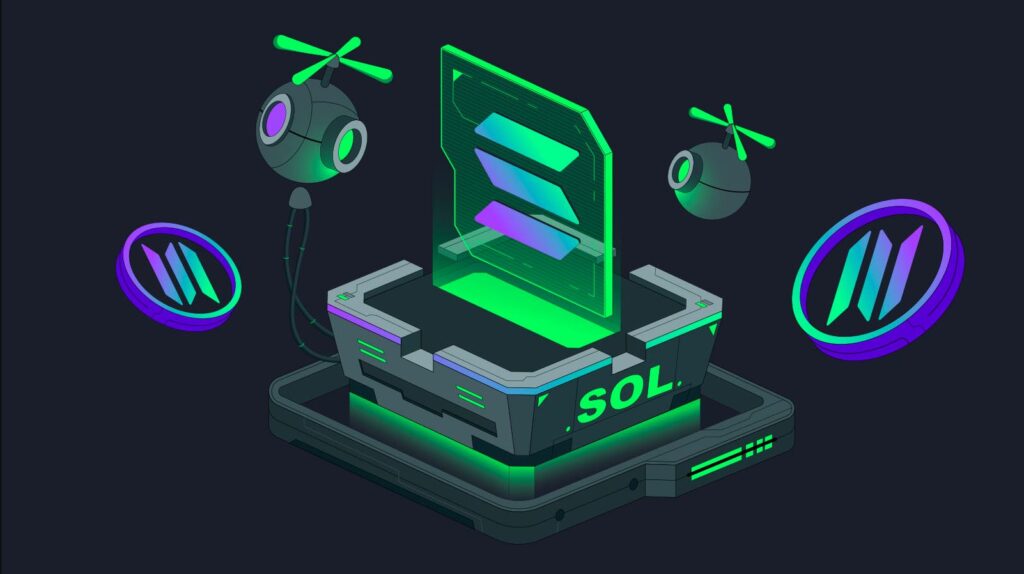Blockchain technology continues to evolve at a rapid pace, and Solana has emerged as one of the most promising projects in the cryptocurrency ecosystem. With its low transaction fees and high network speeds, Solana (SOL) has quickly become a major platform for decentralized applications (dApps). In this article, we will explore what Solana is, its key features, how it works, its price history, and how it compares to other blockchain networks.
What is Solana?
Launched in March 2020, Solana has rapidly become a prominent player in the blockchain space. Currently ranked 5th in market capitalization, with $81.7 billion in total value (as of the time of writing), Solana aims to offer an all-in-one solution for developers to create decentralized applications (dApps) with ease. The blockchain is designed to overcome some of the major challenges faced by other networks, such as scalability, slow transaction speeds, and high fees.
Solana utilizes a hybrid consensus model combining Proof of Stake (PoS) and Proof of History (PoH). This unique combination enables the network to handle a high volume of transactions without sacrificing security or decentralization, making it a scalable solution for decentralized applications.
When Was Solana’s First Block Created?
Solana’s genesis block was created on March 16, 2020, which marked the official launch of its mainnet. From the outset, the Solana blockchain focused on delivering high throughput, efficiency, and competitive transaction fees. This approach has led to widespread adoption by hundreds of cryptocurrency projects, and it is now one of the most popular blockchain networks in the cryptocurrency space.
Key Features of Solana
Solana has a number of key features that make it an attractive blockchain for developers and users:
- High Throughput: Solana boasts a transaction processing speed of over 65,000 transactions per second (TPS). This high speed enables seamless user experiences for decentralized applications built on its platform.
- Scalable Architecture: Solana uses a dual-mechanism approach combining Proof of Stake (PoS) and Proof of History (PoH). This architecture allows the network to scale effectively without compromising security or decentralization.
- Low Transaction Fees: With an average transaction cost of $0.00025, Solana offers one of the most cost-effective environments for financial transactions. This low fee structure is a key factor in attracting users to the platform.
- Developer Tools for Web3: Solana offers an in-built suite of development tools for Web3 projects. One of the most notable tools is the Solana Software Development Kit (SDK), which helps developers build, deploy, and test decentralized applications within the Solana ecosystem, streamlining the development process.
How Does Solana Work?
Solana operates on a hybrid consensus model that combines Proof of Stake (PoS) and Proof of History (PoH) to achieve scalability and maintain low transaction fees:
- Proof of Stake (PoS): Validators use Solana tokens to create new blocks, which they “stake” on the network. Validators are rewarded based on the amount of Solana tokens they stake, encouraging participation and ensuring the security of the network.
- Proof of History (PoH): In addition to PoS, Solana uses Proof of History as a second layer of security. PoH records timestamps and events in chronological order, eliminating the need for validators to sequence transactions. This ensures faster validation and higher throughput as multiple transactions can be processed in parallel, increasing the overall efficiency of the network.
Solana Price History
Solana (SOL) has experienced significant price fluctuations. In 2021, the cryptocurrency reached an all-time high of $259.96 but also witnessed a sharp decline during the bear market of 2022, falling to $7.80 by December 2022.
As of the time of writing, Solana has a market cap of $82.77 billion and a fully diluted valuation of around $103.38 billion. Over the past week, Solana has ranged between $162.47 to $178.32, and currently, it is trading at around $176, reflecting a 13% price increase over the last seven days.
Solana vs Other Blockchains
Solana stands out among the top blockchains for its performance and user base. Here’s how it compares to other popular blockchain networks:
Solana vs Bitcoin
Solana has a Total Value Locked (TVL) of approximately $6.28 billion with a market cap of $82.77 billion. In comparison, Bitcoin’s TVL stands at $429.52 million, reflecting the differences in scalability and low transaction fees. Solana has already achieved fast transaction speeds and low costs, attracting new projects and users seeking to benefit from these features.
Solana vs Ethereum
Ethereum, with its TVL of $121.26 billion and market cap of $297.64 billion, remains the dominant blockchain in the decentralized finance (DeFi) space. However, Solana has an edge over Ethereum due to its faster transaction speeds and lower costs. While Ethereum’s transition to Ethereum 2.0 aims to improve scalability, Solana has already achieved these improvements, making it a more attractive option for new projects and developers.
Solana vs BNB Smart Chain
The BNB Smart Chain has a TVL of $6.05 billion and a market cap of $84.95 billion. Like Solana, the BNB Smart Chain offers fast processing times and low transaction fees. However, Solana’s higher throughput sets it apart, as it can handle a larger volume of transactions with lower latency. Both blockchains are seen as high-performance, low-cost options for DeFi developers, and their growth will depend on user adoption and the development of more scalable applications.
Solana has positioned itself as one of the leading blockchain networks due to its scalability, low transaction fees, and high-speed transaction capabilities. With its hybrid consensus model combining Proof of Stake and Proof of History, Solana can efficiently process a large volume of transactions while maintaining security. While Solana faces competition from established blockchains like Ethereum and Bitcoin, its unique features make it an attractive platform for developers and users seeking faster, cheaper, and more scalable decentralized applications. As more projects adopt Solana and blockchain technology continues to evolve, Solana’s role in the future of cryptocurrency and decentralized finance looks promising.


Thanks